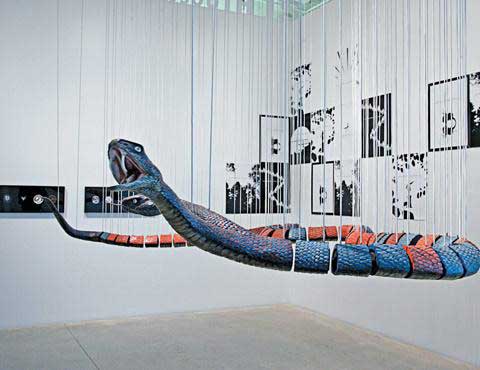|
Time Out New York / Issue 692 :
Jan 1–7, 2009 “Ours: Democracy in the Age of Branding”Sometimes, art about social engagement just doesn’t connect.By Joseph R. Wolin Anna-Maria and Stephen Kellen Gallery, Parsons The New School for Design,
Installation view Photograph: courtesy Parsons The New School for Design What a difference an election makes! Before we all knew that Barack Obama was headed for the White House, Brian Tolle’s DIE, or JOIN (2006), a highlight of “Ours: Democracy in the Age of Branding,” would have felt downright ominous. But now, Tolle’s update on Ben Franklin’s colonial-era cartoon—an oversize, carved, two-headed rattlesnake suspended on wires—seems positively hopeful. Divided into alternating red and blue segments that correspond to the 2004 electoral map, the piece undulates and snaps with a satisfying clacking sound thanks to intermittent magnetic pulses. Still, curator Carin Kuoni’s sprawling consideration of the collision between participatory politics and corporate capitalism feels like its time has come and gone. Red and blue appear as a leitmotif throughout the exhibition: Crimson and navy curtains make video enclosures look like jumbo voting booths. Newsprint handouts and stickers printed in either color join stacks of posters by Sam Durant and Aleksandra Mir, all free for the taking. They inevitably invoke Felix Gonzalez-Torres’s trenchant giveaway works of the 1990s, and in many ways, this show feels like a throwback to that decade’s rash of politically themed projects. The stickers, for example, seem like wan descendants of the visitor badges Daniel Joseph Martinez created for the 1993 Whitney Biennial (they read: I CAN’T IMAGINE EVER WANTING TO BE WHITE). A survivor of those times, Liam Gillick provides the centerpiece for “Ours”: four circular red benches on a large, stepped gray platform. A wall label loftily compares the ensemble to “the process of democracy itself,” and informs us that “the installation triggers a process of continuous reevaluation of one’s actions and position.” It remains unclear just how it does that, exactly, as whatever social or political functions this pretentious furniture may have stays purely symbolic—about as democratic as museum seating or an Ikea showroom. Gillick’s benches have been the setting for a series of collaborative workshops with Parsons students, conceived—along with an online page of links to preexisting websites—as an integral part of the exhibition. Like many of the works in “Ours,” these charrettes led by artists in the show are intended to be earnest and well-meaning. Yet the results—a row of drippy picket signs with slogans like APATHY IS PRISON and SKINNY BITCH; a set of T-shirts ripped, sewn and decorated with colored markers and blue painter’s tape—are rather less than inspiring. Another collaboration, between students and Ashley Hunt, consists of blackboard panels with cartoonish, colored-chalk diagrams that purport to reveal how the political and economic machinations of the world actually operate—the kind of thing Mark Lombardi, another ’90s favorite, did so well. But the drawings merely reproduce portions of the artist’s more complete offset print, A World Map: In Which We See… (2005), that hangs nearby, leading one to wonder what the participants gleaned from such an exercise. A placard admonishes PLEASE DO NOT DRAW ON THE ARTWORK, while on the opposite wall another blackboard encourages visitors to OFFER YOUR OWN DEFINITIONS OF TERMS FOUND ON THE WORLD MAP. Controlling and hectoring, Hunt’s work strongly evokes a prissy schoolteacher. Her infantilization of the audience is not anomalous here—a work by Erick Beltrán invites visitors to make pictures with rubber stamps—but if patronizing the public in the name of interactivity is the best that democracy can engender in art, I may have just become a monarchist. Much better, however is a work with a daunting, paragraph-length title that begins, Even When Social Censorship of Beliefs Is Not So Strict.… Created by the collective the Yes Men, the work takes the form of an empty vitrine placed cryptically in the gallery, along with a mural-size poster adhered to a wall in the lobby. Convincingly camouflaged by slick graphic design and corporate tone as official New School signage, it announces the creation of a New University in Exile, modeled after the heroic rescue of intellectuals fleeing European fascism in the 1930s. Now, the text asserts, the New School will honor that legacy by welcoming Iraqi academics displaced by our current war. Still, while the sign also notes that more than 400 Iraqi university professors have already been killed, it is a complete hoax: Neither the New School nor any other American institution of higher learning plans anything like it. Unlike too much of “Ours,” the Yes Men’s institutional critique is disconcerting, sharp and pointed. Now there’s a brand we can believe in! |
